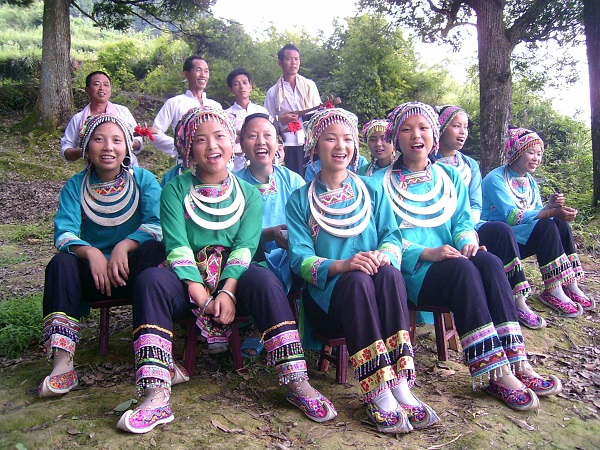Traditions Chorales sans Accompagnement du Peuple des Dong en Chine
De Li Xi, Chef de chœur, Chine
Ma première rencontre avec le chant du peuple des Dong appelé chez eux Ga Lao remonte à 2006 lors des Jeux Mondiaux des Chœurs à Xiamen. Lorsqu’une rangée de belles jeunes filles Dong vêtues de leur robe traditionnelle a lentement fait son entrée sur scène, leur chant était si pur que l’on aurait cru que les voix descendaient du ciel. J’ai été tellement captivé par ce chœur que j’ai décidé de me rendre dans le berceau de cette musique étonnante, Liping, afin de mieux l’appréhender par moi-même. Le comté de Liping borde la province du Guizhou au sud de la Chine. Je vais présenter ci-après ce trésor de la culture chinoise aux amateurs de musique chorale du monde entier.
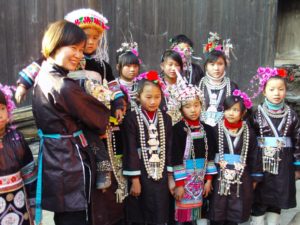
La légende dit que les Dong sont les descendants de la dynastie des Yue dont les racines remontent à 2500 ans. Il y a trois trésors légendaires dans la culture Dong : pont de la Pluie et du Vent, les tours du tambour et le Ga Lao.
La géologie karstique de Guizhou se compose de nombreuses grottes facilement accessibles et où la température y est clémente en hiver et fraîche en été. L’on appelait les personnes de cette région les gens des cavernesparce qu’ellesvivaient dans ces grottes et Dong vient du mot chinois qui désigne la grotte. Les traditions chantées Dong ont commencé avec l’imitation des bruits qu’ils entendaient dans les grottes. Puisque la langue Dong ne s’écrit pas, le Ga Lao est transmis de façon orale et de génération en génération. Par conséquent, le Ga Lao symbolise la culture nationale et confirme le patrimoine culturel.
Le peuple des Dong croit que la nourriture nourrit le corps et que le chant nourrit le cœur. En d’autres termes, les Dong considèrent que les “chants” et le “riz”sont d’égale importance dans leur vie. Le chant est utilisé comme une espèce d’énergie spirituelle qu’ils utilisent pour mouler leur caractère et leur âme.
Les jeunes garçons et les jeunes filles utilisent le chant comme un moyen de faire la cour. Quand la nuit tombe, les garçons chantent des chansons et invitent les filles à chanter avec eux sous la lune. Cette activité s’appelle le Xing Ge Zuo Yue. Ils expriment leur amour et choisissent leur moitié en chantant avec elle.
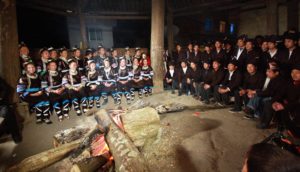
Les sujets principaux des chœurs sont la nature, le travail, l’amour et l’amitié. L’une des caractéristiques de la tradition Dong est d’imiter le bruit des oiseaux et des insectes, des montagnes et des courants ainsi que d’autres sons de la nature. Les chants Ga Lao sont composés par des personnes effectuant des rituels quotidiens.
Les marques de fabrique caractéristiques du Ga Lao incluent des structures à trois voix qui utilisent des bourdons (c’est-à-dire des sonorités soutenues), le chant parallèle et l’imitation.
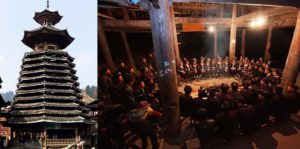
La mélodie principale est habituellement amenée par les voix inférieures et est au premier plan. Les parties pour sopranooupo ur ténor sont dérivées de la mélodie principale et chantées par un(e) soliste ou par un petit groupe de chanteurs. Les voix supérieures improvisent souvent une mélodie au-dessus du matériel primaire dans la partie pour alto ou pour basse. Cependant, la soprano ou le ténor chantera la mélodie principale lorsque la voix inférieur einterprètera un long passage.
Les choristes reçoivent une formation rigoureuse aux méthodes traditionnelles dès leur plus jeune âge ; ils développent alors avec justesse qualité de ton, flexibilité, rythme, indépendance, et mémorisent un nombre extraordinaire de chansons. Chaque village dispose d’un système de formation auquel participent des villageois de tout âge et des deux sexes. Le système est divisé en quatre groupes fondamentaux : chœur des enfants (triple), chœur des jeunes (mixte), chœur des adultes (hommes), et chœur des seniors (mixte). Les membres du chœur des enfants ont entre 8 et 12 ans et restent plusieurs années dans cet ensemble. Ce chœur effectue parfois des représentations du Ga Lao lors de festivals ou lorsque le village reçoit des visiteurs, mais il s’agit avant tout d’un chœur d’apprentissage. Les membres du chœur des jeunes ont entre 17 à 25 ans et cet ensemble est celui qui a le plus grand nombre de représentations.
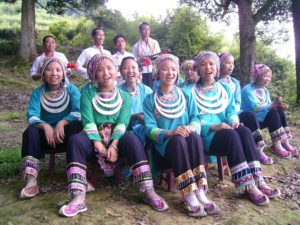
Le chœur des adultes est composé d’hommes mariés étant donné que les choristes féminines doivent abandonner le chœur quand elles se marient. Lorsque le chœur des jeunes n’est pas disponible pour une représentation, c’est le chœur des adultes qui prend le relai.
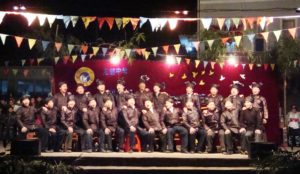
Le chœur des seniors est compose de chanteurs plus âgés, souvent grands-parents. Cet ensemble exécute des ballades et des chants polyphoniques à l’attention des ensembles plus jeunes, mais il n’effectue pas de représentations formelles.
Classification du chœur des Dong
Selon leur style, leur rythme, leurs thèmes, leur style d’interprétation et leur rôle social, les Ga Lao peuvent être divisés dans les catégories suivantes :
Le déclenchement signifie « chansons de bruits », chants qui sont composés des mélodies improvisées avec des textes très brefs. Les chansons ont souvent quelques chants ovales importants antérieurs et après les textes réels. Plusieurs chanteurs chantent le contrepoint dans la voix de soprano ou de ténor. Tous les altos ou basses chantent un bourdon contrastant et les chansons imitent souvent les bruits de la nature : insectes, oiseaux, ou eau dans la rivière.
(Click on the image to download the full score)

Gaxiang sont des « chansons éthiques » et constituent des morceaux éducatifs. Les chansons ont des mélodies onduleuses courtes, elles se concentrent sur le contenu du texte qui fait l’éloge ou critique des morales sociales des Dong.
(Click on the image to download the full score)
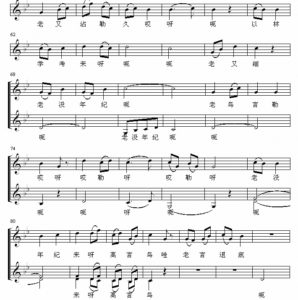
Chansons de travail : Le peuple de Dong chante également ensemble lorsqu’ils rentrent exténués de leur travail. Ce genre de chansons s’appelle les chansons de travail.
(Click on the image to download the full score)
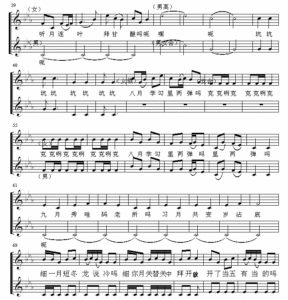
Chansons de culte. La grand-mère est la figure de divinité la plus admirée dans la culture Dong. Ils appellent leur grand-mère Sa. Les Dong organisent une grande cérémonie pour adorer Sa le 3 janvier de chaque année lunaire. Toutes les Dong chantent les chansons de culte ensemble dans cette activité.
Il y a des activités populaires générales de groupe dans les villages Dong qui ont trois noms : Waihei, Waiding, et Waike. Quand toutes les personnes d’un village visitent un autre village et chantent ensemble c’est un Waihei.
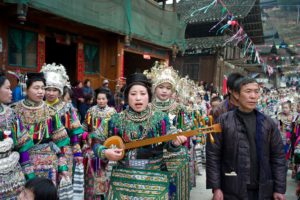
Parfois les jeunes de deux villages se réunissent pour chanter des chœurs ensemble, c’est un Waiding.
Lorsque des membres d’une même famille ou des amis se rendent visite les uns les autres et chantent des chœurs Dong, c’est un Waike.
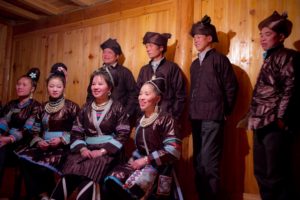
Chansons de Caitang.Quandla fête touche à sa fin,lesDong se tiennentla maintout endansantet en chantant.
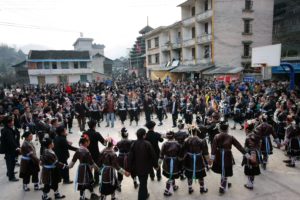
(Click on the image to download the full score)
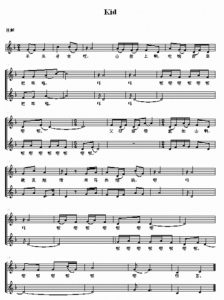
A côté de ces différents types de Ga Lao, il demeure davantage de chansons dans les catégories des chansons pour s’arrêter sur la route, des chansons d’amour, des ballades narratives, des chansons à boire, des chansons de mariage et des chansons funéraires.
Chaque catégorie de chanson comporte des mélodies, des textes et un style différents. Les Dong répètent rarement la même chanson. Chaque professeur de musique Dong a plusieurs milliers de chansons différentes dans sa tête. Les chansons de Ga Lao sont entrelacées avec la culture, les traditions et la vie quotidienne des Dong. Avec tant de personnes qui aiment chanter ce n’est pas étonnant que les villages Dong s’appellent la « mer des chansons et la maison des poèmes ».
Présentation des traditions Dong de Ga Lao au monde entier
Le chœur Dong du comté de Liping a effectué une représentation à Pékin en octobre 1959 ; c’était la première fois qu’ils chantaient ailleurs que dans leur village Dong. Leurs représentations ont suscité un grand enthousiasme et ont eu pour conséquence des invitations pour d’autres représentations. C’était une étape importante pour la tradition de Ga Lao de descendre des montagnes vers le reste du monde. Jusqu’à présent, ils ont effectué des représentations en France, en Italie, en Allemagne et à Singapour pour partager leur répertoire traditionnel. Le 3 octobre 1986, le chœur Dong du comté de Liping a participé au festival d’automne de Paris. Leur représentation au Palais de Chaillot a été si bien accueillie qu’ils ont eu 37 standing ovations. Le Président exécutif M. Josephine, a déclaré : « C’est rare dans le monde qu’un groupe minoritaire de personnes seulement d’un peu plus de deux millions de personnes puisse créer et préserver un chœur folklorique si ancien et authentique ».
Beaucoup de personnes pensaient faussement que la Chine n’avait aucune harmonie dans sa musique, mais le Ga Lao des Dong démontre la polyphonie de la Chine antique. Grâce particulièrement au travail du chef de chœur Yin-Ting Sun, la tradition continue à se transmettre.
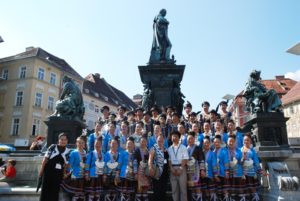
 Li Xi est le chef fondateur du chœur des enfants de langue étrangère de l’école primaire de Shenzhen Yantian en Chine qu’elle a initié en 2001. En juillet 2010, le chœur a remporté la médaille d’or lors de la compétition mondiale des 6èmes jeux internationaux de chœur, prouvant son énorme développement au cours de la dernière décennie. Li XI aime collecter la musique folklorique de rassemblement et l’adapter dans des chansons a cappella. Elle est membre de la fédération internationale pour la musique chorale (IFCM), et en Chine de l’association chorale nationale ainsi que de la société nationale de l’éducation musicale (CSME). Courriel: Jack.zeyu@gmail.com
Li Xi est le chef fondateur du chœur des enfants de langue étrangère de l’école primaire de Shenzhen Yantian en Chine qu’elle a initié en 2001. En juillet 2010, le chœur a remporté la médaille d’or lors de la compétition mondiale des 6èmes jeux internationaux de chœur, prouvant son énorme développement au cours de la dernière décennie. Li XI aime collecter la musique folklorique de rassemblement et l’adapter dans des chansons a cappella. Elle est membre de la fédération internationale pour la musique chorale (IFCM), et en Chine de l’association chorale nationale ainsi que de la société nationale de l’éducation musicale (CSME). Courriel: Jack.zeyu@gmail.com
Traduit de l’anglais par Barbara Pissane (France)
Edited by Cara Tasher, USA

